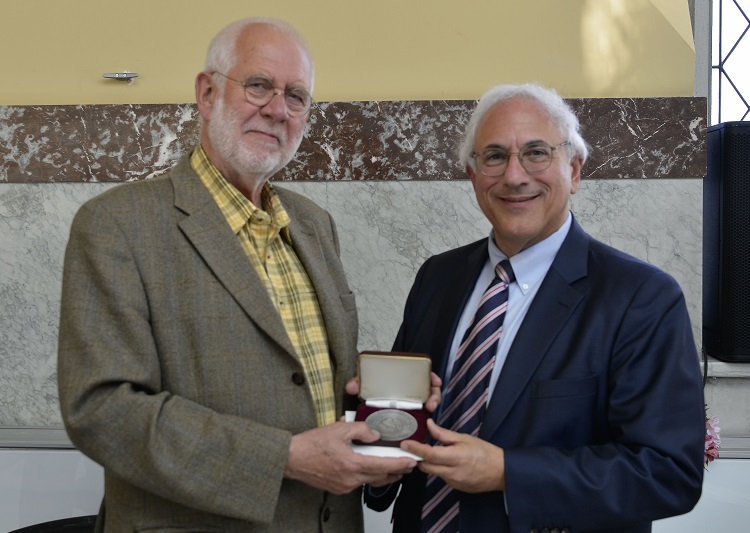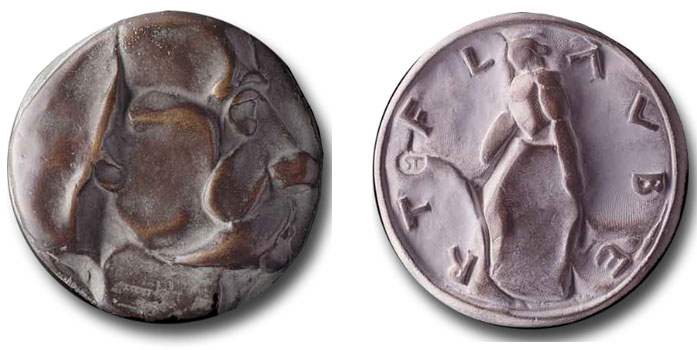Geer Steyn Receives the Saltus Award at FIDEM 2018
Geer Steyn became the fifty seventh recipient of the J. Sanford Saltus Award for excellence in medallic art at the biannual conference of the International Art Medal Federation (FIDEM) in Ottawa, Ontario on May 29, 2018.

Donald Scarinci, Chairman of the Saltus Award Committee of the American Numismatic Society (ANS) presented the award at the American Delegation reception in the Canadian Museum of Nature. It was the first time in the ninety-nine-year history of the award that it was presented outside of New York City.
Geer Steyn became one of only fifty-seven artists who have received the award since it was created with a grant of money to the American Numismatic Society by J. Sanford Saltus in 1919. The silver award medal was designed by Adolf Weinman.
As noted by the ANS, “Geer Steyn’s (b. 1945) studies in sculpture began at the Rijksakademie van beeldende kunsten in Amsterdam, where he initially followed the Academy’s traditional emphasis in figurative work. Thereafter he studied with Fritz Wotruba (1907–1975), a preeminent Austrian abstract sculptor, who greatly influenced Steyn’s subsequent work. Besides his work in medallic art, Steyn is widely known and praised for his large-scale sculptures in stone that have been featured in exhibits alongside his medals.”
The J. Sanford Saltus Award of the American Numismatic Society
The award was created in 1913 when J. Sanford Saltus endowed the ANS with funds to “recognize and encourage excellence in the art of the medal.” The first Saltus award was presented in 1919 to James Earl Frazer. Since then, the Saltus award has become the most prestigious award for medallic art in the world.

“The Saltus award is the equivalent of the Nobel prize for medallic art,” said Scarinci. “To compare it to the Tony Award for theater, the Academy Award for film or the Grammy Award for music would accurately describe the prestige and high regard of the Saltus award,” Scarinci said.
The silver award medal was designed by the Adolph Alexander Weinman who is perhaps most famous for his design of the walking liberty half dollar (1916-1947) which is still produced by the United States Mint today as the one-ounce bullion American silver eagle dollar.
Steyn joins the pantheon of great artists such as: Victor D. Brenner, 1922, Paul Manship, Hermon Atkins MacNeil, 1923; 1925; Lee Lawrie, 1937; Chester Beach, 1946; Sidney Waugh, 1954; Donald DeLue, 1967; Kauko Rasanen, 1986; Gustaaf Hellegers, 2001, Theo van de Vathorst, 2005 and Bogomil Nikolov, 2017.
The Award Ceremony
Three previous recipients of the Saltus award were on hand for the presentation. Eugene Daub, 1991; Jeanne Stevens-Sollman, 1999; Ron Dutton, 2008 join Geer Steyn for his installation into this very select group of great artists.
Donald Scarinci began the presentation by giving a brief history of the Saltus award and thanking the Saltus award committee for their work. The Saltus Award Committee includes Ute Wartenberg, Executive Director of the ANS; Peter Van Alfin, Chief Curator at the ANS; Luke Syson, Curator of European Sculpture at the Metropolitan Museum of Art; Gwen Pier, Executive Director of the National Sculpture Society. He also thanked each member of the Saltus Advisory Board chaired by Philip Attwood, Curator of Coins and Medals at the British Museum.
Donald Scarinci’s remarks about Geer Steyn’s work:
If there is anyone who is still trying to answer the question, “what is a medal,” look at the work of Geer Steyn.
Medals are Sculpture!
It is the artistic vision for a piece that determines whether it should be a monumental work suited to viewing in a large space; or whether it should be a work for the hand with a tactile quality. What we all call “medals” are sculpture. There is no distinction. As much as we might want to make a distinction because of history and tradition, in actuality, there is no distinction at all. The question, “what is a medal,” is a meaningless question.
Geer Steyn’s body of work illustrates this very point. Just look at “Gustav Flaubert,” 1983 or “Maria Callas,” 1995 or his bumble bee year medal for 2018. These hand-held pieces work visually, but holding them, touching them, is the experience. It is communication beyond the visual and beyond the boundary of mere words or text.

Gustav Flaubert, (1983) Front (left), Back (right)

Maria Callas (1995) Front (left), Back (right)
Now look at “Ultimate Portrait,” 1995 or “Tete Feminine,” 2017. The large sculpture reveals themselves through their mass. Their existence in space and time unveil their meaning and create their emotional impact.

Ultimate Portrait (1995) (left), Tete Feminine (2017) (right)
As Steyn himself notes about his work, “limitations in shape, material, technique and content are all abandoned.” For Geer Steyn, the idea, the artistic vision determines whether a piece speaks best from the hand or from its mass in time and space.
Geer Steyn’s Acceptance Speech
A few words accepting the Saltus award.
Thank you Mr. Chairman and thank you, American Numismatic Society to honour me with the Saltus award. A medal for a lifetime achievement.On the reverse you see a powerful horse with two wings.
That gives me the opportunity to share my thoughts and vision about medals.
The medal is a way of visual thinking.
If the medal belongs to the field of arts, it cannot be framed.
The medal is a homeless medium, bravely looking for its own definition.
The medal is a mentality.
The conditions of the subject sometimes given by commissions, theme and text, have to be transferred into an object. The idea must find a physical form: round-square, think-thin, obverse-reverse or totally different, related to other arts by introspection.
Above all, the process evokes one question: what makes form into a medal?
The creative process is a long one and demands the courage of entering into ‘terra incognita’.
You meet, during that period, the necessity of irritation of creative anarchism, liberation and acceptance. Size is more than inches.
The medal is a gesture to open the mind. The medal is communication, a never ending story like water, while it slips through your fingers.
My work has been created directly in clay. It is sculptural and simple in construction. Form has a meaning: that simplicity is the door to my artistic freedom.
The right material on the right spot. All formed by hand and colored by shoe polish.
The medal is a passion.
Geer Steyn .
29- 05 – 2018
History of FIDEM
Established in 1937, the Fédération International de la Médaille d’Art (FIDEM) is dedicated to the practice, appreciation, and promotion of the fine art of the medallion. FIDEM operates in over 40 countries across the globe. Each country, including the United States, is represented by a delegate and a vice-delegate who are tasked with serving as liaison with artists, scholars, FIDEM members, and other citizens interested in the art of medals.
FIDEM also holds biennial congresses, during which the world’s most renowned medallic artists display and discuss their recent works. The event also featured up and coming artists, as well new techniques and materials. In addition to exhibitions, the FIDEM congress also features lectures, meetings, and other events.
FIDEM in Canada for 2018
The XXXV FIDEM Art Medal Congress and Medal Exhibition coincided with the 100th Anniversary year of the enactment of the Canadian statute An Act to confer the Electoral Franchise upon Women. To mark this anniversary, the theme of the 2018 Medal Exhibition is Women and Women in the Natural Sciences. The exhibition includes more than 700 pieces of medallic art by sculptors from 40 countries, all of which were expressly created to promote the anniversary.
Interestingly, the building used to house the 2018 Congress —the Canadian Museum of Nature — was where the country’s law granting women the right to vote was enacted. Due to a fire in the House of Parliament, the building was used in 1918 by the Canadian Parliament.
